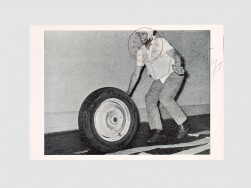The People in Foggia are Terrific
[Die Leute sind ganz prima in Foggia]
- 1974
- Book with 75 silkscreens on brown cardstock
31.3 x 22 x 2.5 cm - Edition: 180 plus XL, signed and numbered
- Publisher: Modern Art Agency, Naples; Studio Marconi, Milan; Edition Staeck, Heidelberg
- Catalogue Raisonné No.: 100
The People in Foggia are Terrific is an artist’s book which provides a history of Beuys’s socialist-oriented artistic activities, from the early 1960s, when he joined the Fluxus movement, until the mid-1970s, when the book was published. Addressing a range of projects that on the surface might seem distinct, it affirms the deeper continuities in Beuys’s practice of this period.
Each page of the book contains a glued-in strip of paper with type-written notes referring to a performance by Beuys. Together, they cover his performances from 1964–1968, beginning with The Chief and concluding with Vacuum⟷Mass. Presented in a non-chronological fashion, they offer a complete, if scrambled, resumé of this phase of his career. The events in question span the period in which Beuys was aligned with Fluxus, whose members aspired, among other things, to develop an egalitarian society conceived in accordance with socialist principles.
The book’s final two pages move beyond these Fluxus years to address the early 1970s, when Beuys turned his attentions to new social and political projects. Abandoning his practice of staging performances in gallery spaces, he sought now to act in the wider public realm, primarily through political channels and grassroots social movements. As this shift unfolded, however, his work retained its socialist outlook.
Such continuity is made apparent on the second to last page of The People in Foggia are Terrific, where the letterhead for the Organisation for Direct Democracy Through Collective Referendum [Organisation für direkte Demokratie durch Volksabstimmung] appears. Beuys co-founded this organisation in 1971 and in doing so took his first steps into the German political arena. Its main aim was to establish a free democratic socialist society, an objective declared explicitly on the book’s final page, where the words THE FIFTH INTERNATIONAL [DIE FÜNFTE INTERNATIONALE] appear. With this declaration, The People in Foggia are Terrific concludes with a call for the founding of a fifth international socialist movement, intended to succeed the first four workers’ internationals, which were established in the 19th and early 20th centuries.
At first glance, the book’s seemingly offhand title might seem to bear no clear relation to its contents. It too, however, alludes to one of Beuys’s social projects, called Difesa della Natura, which was conceived along socialist lines. Throughout the Second World War, Beuys was stationed periodically in Italy, primarily in Foggia. There, he came into contact with agricultural practices and ways of life that had scarcely changed since the Middle Ages. Decades later these experiences would form the basis for Difesa della Natura. Founded in the town of Bolognano in Southern Abruzzo in 1971, the movement engaged in a range of ecological activities, including tree-planting and the revival of premodern agricultural practices. Conceived and initiated privately, the movement put the principles of free democratic socialism into action at a local level.1
By naming the book after the place where he experienced Italy in his earlier years, Beuys suggested that for all its surface-level eclecticism, the deeper continuities in his work reached as far back as the early 1940s.
For an overview of the Difesa della Natura project’s activities, see Ilaria Apostoli, ‘Bolognano: Zufluchtsort für eine Utopie der Kunst,’ in Lucrezia De Dominicio Durini (ed.), Beuys Voice (Milano: Electa, 2011), 382. ↩
© H. Koyupinar, Bayerische Staatsgemäldesammlungen









